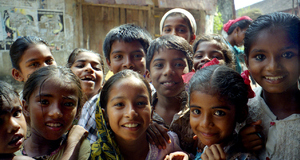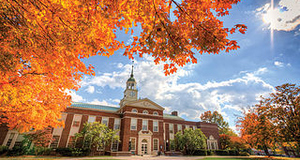From Earth Common Journal VOL. 3 NO. 2Ecological Education: Proposal of Implementation Programs in RomaniaThe Potential of the Educational Institution from Satu Mare County in the Development and Implementation of the Ecological Education Projects The program wants to ensure that there will be no more environmental situations like the one in the picture below. This picture represents an improvised waste deposit. If the students will learn about the impact of waste on the environment, in the future they might sustain the construction of a modern and ecologically friendly waste deposit in the municipality of Satu Mare. In Satu Mare, there are 505 educational institutions: 248 daycares and kindergardens, 230 elementary schools, three special schools for children with disabilities, twenty-six high schools, one trade school, one college, and five university extensions. With regards to literacy, Satu Mare is in 26th place among the Romanian counties, and represents 67% of the students that are enrolled or part of high school and university environment. Moreover, 97.4% of Satu Mare’s population is literate. Specific Activities That Took Place in the Institution that are Recognized experts in the practice of Ecological Education The analysis about specific activities that have Ecological Education principles are based on interviews taken with public persons. In the process of discovery have been used secondary documents of the institution involved in this experiment. The data are from April 2010 and was collected from the following public institutions:
The following departments and offices participated in this case study: From the City Hall of Satu Mare four persons participated in this analysis, two of them representing the Office for the Revitalization of the Green Space, and two from the Program of Economical Development and External Relations, which in our case is the European Integration. At the interview held with agents from the Muncipality we had representatives from the Project Management and The Service for Implementation—which is also known as the Service of Implementation—Regional Waste Management. The interview held with the Agency for Environmental Protection from Satu Mare, was taken with the coordinator of the Department for Public Relations, Communication, Programs and Projects. All data was collected to gain a better understanding of the Ecological Education implemented in this area. Another concern was how much budget was required for the implementations of those projects, and, of course, the future planning that involves the Ecological Education. Another reason was to evaluate what types of programs and projects can be develped in the future for this subject area. Some of the questions that were posed pertain to the below subjects:
After the final interviews, the conclusion reached was that the local authorities know very well the actual problems of the enviroment. In 2000, the Agency for Enviromental Protection, which resides in Satu Mare, has started to include the preoccupation and integration for Ecological Education. The real action of integrating the preoccupation for the Ecological Education started in 2000 through the Agency for Environmental Protection from Satu Mare. The actions initiated by this Agency have been followed by the City Hall and the Municipality. One example of unification of the efforts and partnership was between the local authorities and the Circle of Ecofriends formed of fifty children with ages between 14 and 18 years old, and was discussed in the weekly meetings organized every Wednesday. The children were able to discuss the everyday problems that happen in nature and what action they are going to take and make things right. Another action taken into consideration by the local authorities was the implementation of some preparatory courses for the teachers in order to grasp new knowledge about ecological education. The teachers were also introduced to new types of games and competitions with ecological themes that they can implement for children of all ages. Another initiative promoted by this program was the correct selection of the residual waste by the local population. Another important progress that was regisitered after the implementation of the program was the constant effort from the side of the local authorities and the teachers to keep a clean environment. The table on the following page breaks down exactly the initiatives that each institution was responsible for creating.
From this table we can see that the Agency for the Environmental Protection has the greatest implication in the realization of the development and sponsorship of the ecological educational initiative. Unfortunately, the Ecological Education is not part of a special budgeting system and relies mostly on donations and sponsorships. Future planning involves new ideas such as the development of an Eco Center which will offer space for lectures and school activities (the school would ensure that the children stay for free). Another idea is the development of a partnership with the Society Carpatina Ardeleanu (EKE Szatmarnemeti)—the Satu Mare branch, and also the creation of a space that will offer the possibility for teachers to teach about ecology to kids coming for summer school. This centre will have a social component and will organize summer camps for children from poor families who don’t have the resources to send their kids to another place for summer. In the end, all we can say about the ecological education is that it is a complex process of recognition of the values about the environment. We need to give the promotion that was intiated by the Satu Mare County a chance. In 2009 Satu Mare had shown a lot of initiative in the ecological education area and for its efforts has received international recognition. At the end of 2008, Satu Mare received the Green Flag from the World Wide Educational Foundation for the Environment. Sometimes we just jump into the new without being prepared, even with good intentions, and we end up hurting the economic and ecological equilibrium. All of the three themes of the conference — e3=earth education economics — if treated as interrelated elements, will lead to a more careful exploration and in the end will bring to the nation more prosperity and understanding. One way to achieve this relation is by applying the principles of sustainable business practices and exploration. AuthorMia Isabela Deleanu is a graduate of the Library and Information Technology program at MacEwan University, as well as Records Management, a Human Resources Certificate (NAIT), and a Masters degree in Bulgarian Language and Literature. In 2008, Mia represented the Central University Library “Carol I” at the National Conference of Romanian Librarians with her paper “The Romanian Libraries in the Digital Word”. She also published two papers, “The book a mysterious universe for the readers from XXI century” (2005) and “Kaleidoscope for Holiday” (2001) in Biblioteca—papers that commented on the presence of mind of today’s readers and their reading habits. She is also the author of three books: Caleidoscop (poetry, short fiction, and drama published in 2006), Wandering with Angels (short stories published in 2003), and The Merchant of Dreams (short stories, published in 2002), all of them under the name Isabela Barzoaga. Under the same name, she also published short stories and poetry in the Ferestre spre lumina “Windows into the light” (2002), Rascrucea dintre ganduri “Crossing between the thoughts” (2002), and Strigatul din corn de luna “The scream from the half-moon” (2003) anthologies. In 2011, Mia became involved in professional and student organizations including: Student Program Advisory Committee at Grant MacEwan University for the Library and Information Technology program, The Great Edmonton Library Association (GELA), Alberta Library Association (ALA), the Association of Records and Information Management (ARMA)—Edmonton Chapter (ARMA), and the Alberta Writers Guild. Currently, Mia is interested in getting more involved in understanding how ecology is represented in school curricula. ReferencesCombes, B. (2005). The United Nations Decade of Educatation for Sustainable Development (2005 – 2014): Learning to Live Together Sustainably. Applied Environmental Education & Communication, 4(3), 215-219. David E Gammon, Jennifer M Platania, Susan Manring, and David Muñoz. (2011). Economics: the overlooked discipline in Earth Stewardship. Frontiers in Ecology and the Environment 9. 535–535. http://dx.doi.org.ezproxy.macewan.ca/10.1890/1540-9295-9.10.535 Dawson, Chad P. (2009). Wilderness management: Stewardship and protection of resources and values. Boulder, CO.: WILD Foundation Educatia Ecologica (2010-2013) [pdf] retrieved on 1 March from http://eke.ro/document/Raport%20de%20cercetare_EDUCATIE%20ECOLOGICA.pdf Energy, transport and environment indicators – Eurostat –Europa (2012). March 1, 2013. Retrieved from: www.epp.eurostat.ec.europa.ca/cache/ITY…/KS-DK-11-001-EN.PDF Irwin, H. (2007). Restoring Nature’s capital: An action agenda to sustain ecosystem services. Washington, DC: World Resources Institute. Romania Libera (12 October, 2012) Imagini Nasa confirma dezastrul din padurile romanesti: o suprafata uraisa de molid a disparut din Harghita in numai trei ani. March 2, 2013. Retrieved from: http://www.romanialibera.ro/exclusiv-rl/investigatii/imagini-nasa-confirma-dezastrul-din padurile-romanesti-o-suprafata-uriasa-de-molid-a-disparut-din-harghita-in-numai-trei-ani-280819-main_pic4.html Romania prinde radacini/ Mai mult verde (nov. 2009). Article retrieved on 1 March 2013 from http://www.maimultverde.ro/project/romania-prinde-radacini Satu Mare Urbact [pdf] (2010). Retrieved 3 March 2013 from http://urbact.eu/fileadmin/Projects/Reg_Gov/partners_media/CP_Satu_Mare.pdf Shin, D. S. (2000). Environmental education course development for preservice secondary school science teachers in the Republic of Korea. Journal of Environmental Education, 31(4). 11-18. (retrieet April 12, 2013) Wilderer P. A. Schroeder E.D & Kopp, H. (2005). Global sustainability: the impact of local cultures: a new perspective for science and engineering, economics and politics. Wiley: VCH. Appendix I: Collected Data by Eurostat/European Environment AgencyThe following screenshots offer collected data by Eurostat and the European Environment Agency and are from the chapter: Forestry and Biodiversity (pp. 182-186), Energy, transport and environment indicators – 2012. In 2010, public wood harvest in the EU-27 averaged 3.65 m3/ha, while private wood harvest averaged 3.22 m3/ha. Among member states, the highest values were recorded in Belgium (7.08 for public and 7.15 for private). High values for public harvest were also recorded in Slovakia (6.70) and the Czech Republic (6.31), while private harvests were high in the Czech Republic (6.74) and Austria (5.59). The density of growing stock of forests for the EU-27 averaged 153.52m3/ha in 2010. The Member States with the highest growing stock densities occurred in Slovenia (331.76) and Germany (315.28), while the lowest values were observed in Malta (0), Greece (47.40), Spain (50.27), and Cyprus (50.98). In 2010, the average net annual increment in the EU's forests that were available for wood supply was 5.79 m3/ha. Among member states, the net annual increment ranged from 0.92 m3/ha in Cyprus to 10.12 m3/ha in Germany. The European Union's policy to fight illegal logging and associated trade was defined in 2003 with the Forest Law Enforcement, Governance and Trade (FLEGT) Action Plan. The key regions and countries targeted in the FLEGT Action Plan, which together host nearly 60% of the world’s forests and supply a large proportion of internationally traded timber, are tropical Africa, Russia, tropical South America, and southeastern Asia. The FLEGT Action Plan, endorsed by the EU Council of Ministers in November 2003, covers both supply-side and demand-side measures to address illegal logging. A key element of the FLEGT Action Plan is a voluntary scheme to ensure that only legally harvested timber is imported to the EU from countries participating in the scheme. The EU's legal framework (Eurostat Pocketbooks, p.185) is a regulation adopted in December 2005 and a 2008 Implementing Regulation. They allow for the control of timber imported to the EU from countries that have entered into bilateral FLEGT Voluntary Partnership Agreements (VPA) with the EU. The European Commission has been given a mandate from the Council of Ministers of the EU to conduct negotiations in view of concluding such FLEGT VPAs. The first VPA to be concluded was with Ghana. Suggested Reading from Inquiries Journal
Inquiries Journal provides undergraduate and graduate students around the world a platform for the wide dissemination of academic work over a range of core disciplines. Representing the work of students from hundreds of institutions around the globe, Inquiries Journal's large database of academic articles is completely free. Learn more | Blog | Submit Latest in Environmental Studies |

![Figure 5. Courtesy of 10 Project Partner 8: Satu Mare [Romania]](/imgs/640/scale/article-images/j7/i24/a84/image-5.jpg)




























